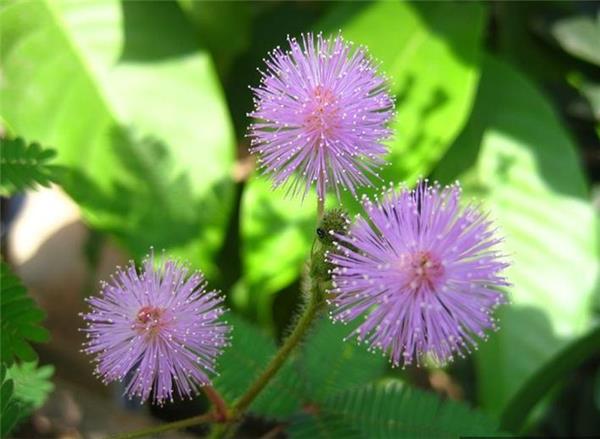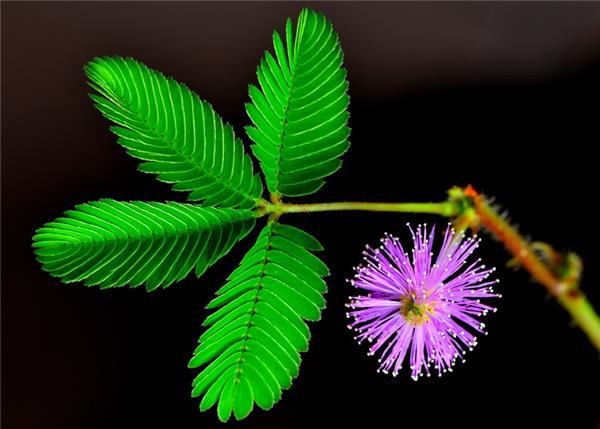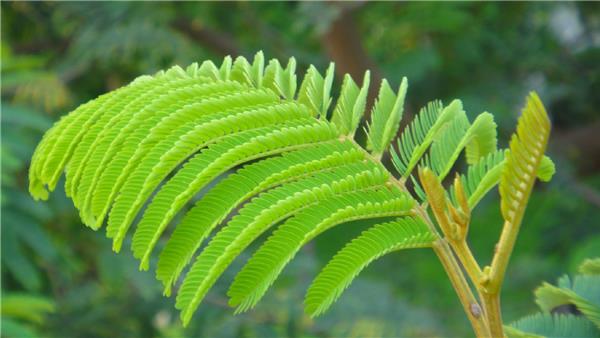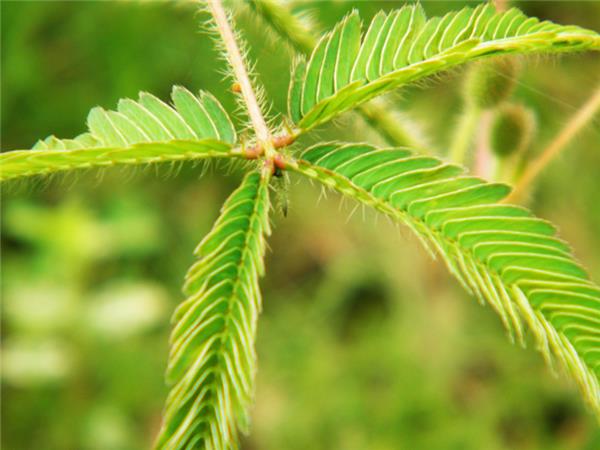[mimosa is not shy] the reason why mimosa is shy and not shy
Mimosa itself is famous for its shyness, and people raise it mainly to appreciate its characteristic, but some friends have raised mimosa for a period of time, only to find that their mimosa is no longer shy. Why?

First, the characteristics of mimosa
The most obvious is that when it is stimulated (such as touching), the leaves of mimosa will immediately contract and come together. If the stimulation is strong, it will soon be transmitted to the adjacent leaflet or even the leaflet of the real compound leaf, making the petiole droop. Mimosa also responds quickly to stimuli, which usually begins to respond after 0.1 seconds and is completed in a few seconds.
Second, why the mimosa is shy
In the position of the petiole and the base of the leaf of mimosa, there is an inflated part, which is called the leaf pillow. And the leaf pillow is the core reason for the shyness of the mimosa. There is a vascular bundle in the middle of the leaf pillow, surrounded by parenchyma. When the leaf pillow which is most sensitive to stimulation is touched, it will cause the cell fluid of the parenchyma cells in the upper half of the leaf occipital to be discharged, resulting in an imbalance of swelling pressure between the upper and lower halves, resulting in the closure and sagging of the leaves.
The stress behavior of mimosa takes only 0.08 seconds before and after the occurrence, that is to say, the conduction velocity is as high as 10cm/s, which can be said to be very fast. It takes about 5-10 minutes to restore the original state.
The reason why mimosa is shy is closely related to its native environment. The shy prairie comes from tropical South America, where the climate is bad and there are often high winds and torrential rains. In order to protect itself, when the first drop of Rain Water falls on the mimosa leaf, it will close the leaf promptly and effectively and hang its petiole to avoid the damage of the storm, which is the self-adjustment of the biological world.

Third, how to raise mimosa
1. Choose a suitable place for planting, indoor pot planting is a better practice. The fibrous root of mimosa is few and thin, so it is suitable for sowing and reproduction, and it is best to adopt the method of direct seeding to avoid root injury by transplantation. if you want to transplant, you can choose in the seedling stage.
2. Assist the mimosa to reproduce. When the reproduction is luxuriant and messy, you can choose to plant it in separate pots to ensure adequate light and nutrition.
3. Another thing to remind you is that mimosa can't be planted with colored chili, because there are red spiders on colored chili, which will kill mimosa.

Fourth, the reason why the mimosa is not shy
The first is that it is still shy at the beginning, but how can it not be shy after touching it many times? The reason is very simple, because this friend touched many times, although the mimosa needs external stimulation to be shy, but if stimulated frequently, it will lose its sensitivity.
Another situation is that after mimosa is stimulated, the contraction rate of leaves becomes slower because of high water content. In the neck of the mimosa leaf, there is a small drum-shaped parenchyma cell tissue-the leaf mattress, which is filled with water. when you touch the mimosa leaf with your hand, as soon as the leaf vibrates, the water in the lower cell of the leaf mattress immediately flows upward to both sides. in this way, the lower part of the leaf mattress shriveled, while the upper part bulged, the petiole sagged and the leaf closed. Therefore, the closure and opening of leaves are caused by the swelling and pressure of leaf mattresses. The expansion and pressure of the leaf mattress is closely related to the humidity in the air. When the air humidity is very small, the expansion and pressure effect of the leaf mattress is obvious, and the closing and opening speed of the leaf is fast; when the air humidity is very high, the opening and closing speed of the leaf is slow.

It seems that even the introverted and shy mimosa has a temper, and it will feel unhappy after people touch it too much. So in order to ensure its shyness and let it show its unique side, we should avoid touching it as little as possible and let it grow quietly.
Related
- Wuhan Hospital Iron Tree Blooming Result Was Instantly Frightened by the Gardener Master
- Which variety of camellia is the most fragrant and best? Which one do you like best?
- What is the small blue coat, the breeding methods and matters needing attention of the succulent plant
- Dormancy time and maintenance management of succulent plants during dormancy
- Minas succulent how to raise, Minas succulent plant pictures
- What are the varieties of winter succulent plants
- How to raise succulent plants in twelve rolls? let's take a look at some experience of breeding twelve rolls.
- Attention should be paid to water control for succulent plants during dormant period (winter and summer)
- Watering experience of twelve rolls of succulent plants
- Techniques for fertilizing succulent plants. An article will let you know how to fertilize succulent plants.



